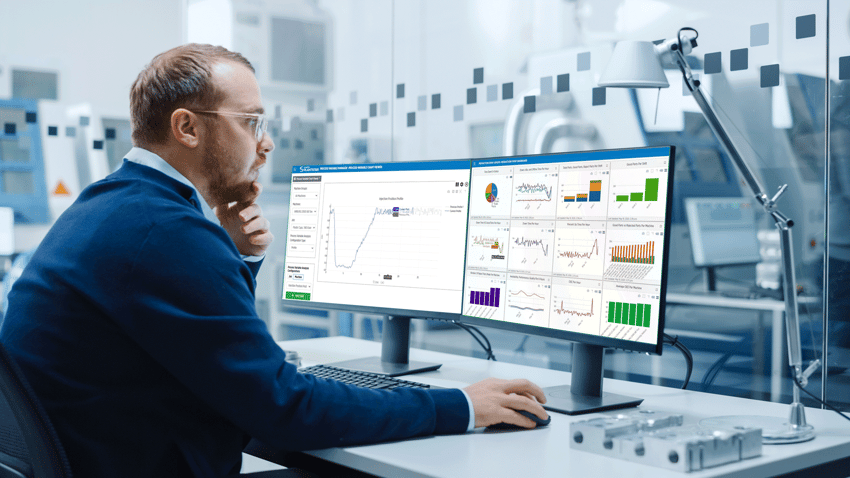PlantStar BLOG
10 Important Data Points that Illustrate Manufacturing Efficiency
Feb 10, 2022 5:00:00 PM / by David Crowley

The manufacturing industry has gone from a time when companies had no visibility into the performance of their equipment to now where they can see just about anything. As a result, manufacturers find themselves facing a new challenge in trying to maximize factory floor efficiency: What data points do they really need to monitor in order to improve their manufacturing process? So, let’s highlight 10 key metrics.
A few recent technical advances altered the manufacturing landscape dramatically. In the past, suppliers had little to no visibility into their equipment because it was not intelligent. As a result, they were reactive rather than proactive in addressing problems simply because they did not know which items were working well and which were about to fail.
The Internet of Things (IoT) enables manufacturers to outfit their equipment with sensors, small special-purpose microprocessors that collect performance data. Because machines run almost continuously during their scheduled run times, IoT devices now provide insight into how well they are functioning. Machine sensors track variable data, like pressure, temperature, humidity, vibrations, acceleration, and power levels.
The Importance of a Manufacturing Execution System
Coupling IoT sensors with a Manufacturing Execution System (MES), like PlantStar, enables producers to collect production monitoring and process monitoring information for analysis. Consequently, personnel better understand the strengths and weaknesses of their manufacturing processes. Production Monitoring tracks how quickly parts are produced. Process Monitoring measures different variables, such as temperature, pressure, and hold time, that impact equipment performance. This real-time data collection empowers manufacturers, so they understand their equipment’s health, make changes to boost throughput, and raise Overall Equipment Effectiveness.
PlantStar 4.0 gathers a wide range of qualitative data. It tracks Cycle Time, Shot Size, Injection Pressure, Hold Pressure, Hold Time, Cushion, and Position. Production process data including Machine and Tool Cycles, Good and Bad Part Counts, Up Time and Down Time, and Reject, Assist, and Downtime Events.
Collecting and consolidating this information is a vital step toward understanding how your equipment is functioning. The MES solution then uses artificial intelligence, machine learning, and data analytics to create a better understanding of how materials are flowing, goods are being produced, and shipments are progressing.
What Data is Vital to Manufacturing Operations?
As real-time data volumes have grown, suppliers gained many options for what information they track.
Ten key data points manufacturers should monitor include:
- Production Volume: a vital statistic; the number of products created on the plant floor during a run.
- Throughput: The number of finished products that a machine or production line churns out during a specific period.
- Machine Uptime and Downtime: also known as run time, this number is the actual minutes that a device operates during a specific period. This metric also highlights time wasted during stoppages, breakdowns, or shift changeovers.
- Tool Life Tracking: monitors the time that has passed and the number of cycles that an individual tool was used for. These measurements require access to Tool Maintenance information, the details of any work performed on the tool.
- Mean Time Between Failures: a metric that shows how much time passes between device failures.
- Mean Down Time: this data point illustrates the time required for equipment repair, maintenance, or replacement.
- Material Lot Tracking: tracks material lot numbers from ERP work orders through production and associates materials to lots, jobs, work orders, and finished goods, an important time for traceability and gauging shop floor performance.
- Material Usage Reporting: generates reports on materials by job, shift, day, or other periods. The data can be exported to ERP applications for further analysis.
- Material Forecasting: anticipates material usage/demand based on scheduled jobs and materials specifications.
- Operator Action Events: auto-generated data for each time an operator logs into or out of the system. Auto displays all operators on when they checked into a machine/station and where they are checked in on the shop floor.
Improve the Manufacturing Process
Collecting these items empowers manufacturers to enhance their business. They use the data to fine-tune their operation. Possible improvements from ongoing and real-time data collection include:
- Boost productivity by automating routine tasks
- Reduce defective items
- Lower downtime
- Shorten production run times
- Improve customer satisfaction
- Increase profitability
Manufacturers have gained more information about equipment performance as technology recently advanced. They now need to determine which items are most important to their business. A few helpful items include tracking production volume, machine uptime and downtime, Operator Action Events, and User Action Events. Monitoring those events more closely enables manufacturers to improve their operations and strengthen the business.

Featured E-Book
Discover the revolution that awaits your manufacturing process and step into the world of smart factories! Don't miss out on the opportunity to elevate your business to new heights. Download our featured ebook, "How Production and Process Monitoring Improve Your Manufacturing Process," and unlock the potential of a Manufacturing Execution System (MES) to break down barriers, automate processes, and streamline your operations. Learn how to harness the power of intelligent equipment, IoT, Big Data, and AI to continually improve your operations, decrease machine downtime, reduce paperwork, and lower labor costs. Embrace the future of manufacturing and build a smart factory today! Click here to get your copy now and start transforming your business.
Topics: Manufacturing Execution Systems
Subscribe to Email Updates
Posts by Topic
- Manufacturing Execution Systems (38)
- manufacturing solutions (16)
- MES 101 (13)
- Industry 4.0 (11)
- improve efficiency (10)
- Plastic Molding (9)
- Plastics Technology (9)
- mes software (9)
- mes solutions (9)
- MES hardware (8)
- Shop Floor Production (8)
- digital transformation (7)
- Reduce scrap (6)
- data-driven-decisions (6)
- Medical molding (5)
- lean manufacturing (5)
- process monitoring (5)
- product quality (5)
- lights-out manufacturing (4)
- manufacturing dashboard (4)
- production monitoring (4)
- ERP integration (3)
- Shop Floor Safety (3)
- supply chain management (3)
- Injection Molding Technology (2)
- defect collection (2)
- machine mes (2)
- process variables (2)
- digital strategy (1)
- labor gap (1)
- throughput (1)


